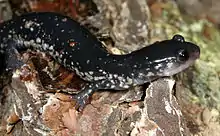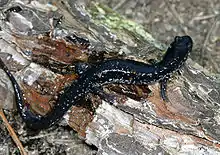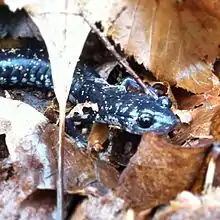Northern slimy salamander
The northern slimy salamander (Plethodon glutinosus) is a species of terrestrial plethodontid salamander found throughout much of the eastern two-thirds of the United States.
| Northern slimy salamander | |
|---|---|
 | |
| Scientific classification | |
| Kingdom: | Animalia |
| Phylum: | Chordata |
| Class: | Amphibia |
| Order: | Urodela |
| Family: | Plethodontidae |
| Subfamily: | Plethodontinae |
| Genus: | Plethodon |
| Species: | P. glutinosus |
| Binomial name | |
| Plethodon glutinosus (Green, 1818) | |
| Synonyms | |
| |
Geographic range
P. glutinosus is found from New York, west to Illinois, south to Mississippi, and east to Alabama, with isolated populations in southern New Hampshire and northwestern Connecticut.[2]
Common names
The northern slimy salamander is called so due to the slimy texture of its skin. It is also sometimes referred to as the viscid salamander, grey-spotted salamander, slippery salamander, or sticky salamander, depending on which source is consulted.[3]
Taxonomy
P. glutinosus is one of 57 species in the genus Plethodon and was one of the first of its cogeners to be described. Due to its large geographic range, some taxonomic researchers have suggested splitting P. glutinosus into several distinct species, but this is not widely accepted.
Description

The northern slimy salamander is typically an overall black in color, with numerous silvery spots or gold spots across its back. It is usually 12–17 cm (4.7–6.7 in) in total length (including tail), but can grow to 20.6 cm (8.1 in).[4] Males are not easily distinguished from females, though females tend to be slightly larger. It has 15-17 costal grooves.

Behavior
All plethodontid salamanders are territorial, and fight aggressively for territory. Their preferred habitat is in moist soil or leaf litter beneath stones, rotting logs, or other debris near a permanent water source. They sometimes make use of other animals' burrows. Their diet consists primarily of ants, beetles, sow bugs, and earthworms, but they will consume most kinds of insect.
Reproduction
Breeding of P. glutinosus takes place in the spring, and courtship consists of the males performing a sort of dance to attract the females' attention. Females lay clutches of four to 12 eggs in a moist area, which she guards, often neglecting food for the period until they hatch. Hatchlings emerge from the eggs in about three months, having no aquatic stage, like many other salamander species. They instead develop directly into their entirely terrestrial adult form. Maturity is not reached for two to three years.
References
- IUCN SSC Amphibian Specialist Group (2014). "Plethodon glutinosus ". IUCN Red List of Threatened Species. 2014: e.T59340A56365349. doi:10.2305/IUCN.UK.2014-1.RLTS.T59340A56365349.en.
- Powell, Robert; Conant, Roger; Collins, Joseph T. (2016). Peterson Field Guide to Reptiles and Amphibians of Eastern and Central North America, Fourth Edition. Boston and New York: Houghton Mifflin Harcourt. xiv + 494 pp., 207 figures, 47 plates. ISBN 978-0-544-12997-9. (Plethodon glutinosus, pp. 82-84 + Plate 6).
- "Amphibian Species of the World 6.0". AMNH. Retrieved 21 October 2019.
- Conant, Roger (1975). A Field Guide to Reptiles and Amphibians of Eastern and Central North America, Second Edition. Boston: Houghton Mifflin. xviii + 429 pp. + Plates 1-48. ISBN 0-395-19979-4 (hardcover), ISBN 0-395-19977-8 (paperback). (Plethodon glutinosus, pp. 276-277 + Plate 41 + Map 230).
External links
- Animal Diversity Web: Plethodon glutinosus
- Amphibian Species of the World: Plethodon glutinosus
- Caudata Culture Species Entry: Plethodon Complex
| Wikimedia Commons has media related to Plethodon glutinosus. |
Further reading
- Behler, John L.; King, F. Wayne (1979). The Audubon Society Field Guide to North American Reptiles and Amphibians. New York: Alfred A. Knopf. 743 pp., 657 color plates. ISBN 0-394-50824-6. (Plethodon glutinosus, pp. 340-341 + Plates 140, 141).
- Green, Jacob (1818). "Descriptions of several species of North American AMPHIBIA, accompanied with observations". J. Acad. Nat. Sci. Philadelphia 1: 348-359. (Salamandra glutinosa, new species, p. 357). (in English and Latin).
- Zim HS, Smith HM (1956). Reptiles and Amphibians: A Guide to Familiar American Species: A Golden Nature Guide. Revised Edition. New York: Simon and Schuster. 160 pp. (Plethodon glutinosus, pp. 147, 157).
